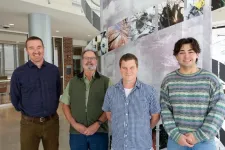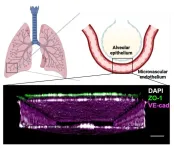(Press-News.org) Glioblastoma is the most common type of brain tumor that affects adults and, unfortunately, still remains incurable. In a new study, researchers have demonstrated that a specific mitochondrial protein plays an important role in glioblastoma, and can therefore be used as a potential target to reduce tumors.
“Glioblastoma is notorious for its lethality. One of the major challenges is that it spreads invasively throughout the brain. We’re interested in understanding what drives this process in order to identify new therapeutic strategies,” said Brendan Harley (RBTE leader/EIRH), the Robert W. Schaefer Professor of Chemical and Biomolecular Engineering.
In the current study, the researchers focused on the mitochondrial coiled-coil-helix-coiled-coil-helix domain containing protein 2—also known as CHCHD2. The complicated name refers to the structure of the protein, whose subunits are coiled together like rope strands.
The researchers first looked at The Cancer Genome Atlas glioblastoma database to see whether they could spot any patterns that related CHCHD2 levels to cancer. Out of 577 samples, they found that the CHCHD2 genes had higher expression in tumor cells, compared to non-tumor tissue, and was higher in advanced cases of glioblastoma.
“We also learned that in humans the gene encoding CHCHD2 was closely linked to the gene encoding the epidermal growth factor receptor, or EGFR, on chromosome 7. A mutated version of this protein is found in over 50% of glioblastoma patients,” said Rex Gaskins (RBTE), the Keith W. and Sara M. Kelley Endowed Professor of Immunophysiology in Animal Sciences and corresponding author of the study.
When the results from the database showed that CHCHD2 expression was highest in the patients who harbored the mutation known as EGFRvIII, the researchers realized that understanding the interaction between these two proteins can be crucial to understanding glioblastoma progression.
To confirm their hypothesis, the researchers looked at the effects of CHCHD2 on tumor growth in mice. They compared mice that had CHCHD2 and the mutated version of EGFR to mice that did not contain CHCHD2, but still had mutated EGFR. The first group of mice survived for an average of 17 days, whereas the second group survived for 25 days. The researchers found that the mice that died earlier had more tumor growth infiltrating the surrounding brain tissue.
Although it is evident that these proteins are interacting with each other, it is unclear how they affect glioblastoma progression. The authors have proposed several mechanisms, based on their experiments.
The first possibility is that CHCHD2 decreases the sensitivity of mutated EGFR to cytotoxic drugs. Patients with glioblastoma only survive for 15-20 months, despite being subjected to an arsenal of treatment procedures, including chemotherapy with the drug temozolomide. The researchers used this drug and tested cells that had the mutated EGFR protein and CHCHD2 and cells that only had EGFR. They saw that when cells did not contain CHCHD2, they were more sensitive to temozolomide. The researchers believe that this result highlights CHCHD2 as a potential therapeutic target.
Another possibility is that CHCHD2 affects how EGFR stimulates glioblastoma invasion. Using a hydrogel to replicate the tumor microenvironment in the brain, the researchers showed that cells with both CHCHD2 and mutated EGFR were able to grow and invade the surrounding area. This invasion was especially pronounced when the level of oxygen was lower, a condition commonly experienced by glioblastoma cells as they invade from the tumor into the brain.
The data also demonstrate that CHCHD2 profoundly affects cellular metabolism, which the researchers showed using different biochemical tests. “It’s a multifaceted paper that used patient data, human cell lines, and a mouse model of glioblastoma,” Gaskins said. “All of our data are aligned and we can pursue any one of these mechanisms to see if it explains what is happening in the tumors.”
The researchers are interested in figuring out why the invasive capacity of these cells change, especially under low-oxygen conditions. They also want to test whether these results hold true in other types of glioblastomas, which may not have a mutated EGFR.
“This study suggests that the role of CHCHD2 in glioblastoma progression was underappreciated, but it might be a significant new target as we try to improve clinical outcomes,” Harley said. “The idea that this protein can change behavior based on its environment is valuable. We hope that researchers can start identifying new therapeutic strategies based on this key protein.”
The paper “CHCHD2 mediates glioblastoma cell proliferation, mitochondrial metabolism, hypoxia induced invasion and therapeutic resistance” was published in the International Journal of Oncology and can be found at https://pubmed.ncbi.nlm.nih.gov/37654190/. The work was funded by the NIH, and the Department of Chemical and Biomolecular Engineering and the Cancer Center at Illinois.
The work was led by Jan Lumibao and Jee-Wei Emily Chen, former trainees in the NIH-funded Tissue Microenvironment Training Program at Illinois, as well as current animal sciences graduate student Payton Haak.
END
Mitochondrial protein plays key role in glioblastoma and therapeutic resistance
2023-10-17
ELSE PRESS RELEASES FROM THIS DATE:
Whaling wiped out far more fin whales than previously thought
2023-10-17
Key takeaways
Whaling in the 20th century destroyed 99% of the Eastern North Pacific fin whale breeding population.
Because there is enough genetic diversity, current conservation measures should help the population rebound without becoming inbred.
The future of fin whales in the Gulf of California depends on the recovery of the Eastern North Pacific population.
A new genomic study by UCLA biologists shows that whaling in the 20th century destroyed 99% of the Eastern North Pacific fin whale breeding, or “effective,” population — 29% more than previously thought.
But there is also some good news: Genes among members of this endangered ...
Human Lung Chip leveraged to faithfully model radiation-induced lung injury
2023-10-17
By Benjamin Boettner
(Boston) — The lung is one of the tissues most sensitive to radiation in the human body. People exposed to high radiation doses following nuclear incidents develop radiation-induced lung injury (RILI), which affects the function of many cell types in the lung, causing acute and sustained inflammation, and in the longer term, the thickening and scarring of lung tissue known as fibrosis. RILI also is a common side effect of radiation therapy administered to cancer patients to kill malignant cells in their bodies, and can limit the maximum radiation dose doctors can use to control their ...
Texas A&M receives over $1 million in USDA grants to study SARS-CoV-2 in deer
2023-10-17
Texas A&M University scientists and research partners have received two National Institute of Food and Agriculture (NIFA) Agriculture and Food Research Initiative (AFRI) grants to study the spread of SARS-CoV-2 in deer. These funds will help researchers understand the impact of the virus in Texas’ deer populations and its relationship to human and ecological health.
For these projects, the research team will focus on captive deer, which are an agricultural species in Texas, including managed deer that live on large, rural properties enclosed by fences, as well as on the wild deer with which captive deer may interact and deer living ...
SwRI develops novel solution to advance synthesis for nerve agent antidotes
2023-10-17
SAN ANTONIO - October 17, 2023 — Southwest Research Institute has developed a unique technology (US20230242487A1) that enables the safe and efficient synthesis of organophosphorus nerve agent (OPNA) oxime antidotes. Using this technology, SwRI scientists can not only successfully synthesize currently known highly effective nerve agent countermeasures, but also effectively develop promising new drug candidates to treat nerve agent exposure.
Current treatments for OPNA exposure have not changed significantly since the 1950s. OPNAs are odorless and colorless chemicals ...
The Foundation for Angelman Syndrome Therapeutics to advance gene therapy candidate through IND-enabling studies conducted in partnership with the University of Pennsylvania
2023-10-17
October 17, 2023—The Foundation for Angelman Syndrome Therapeutics (FAST) announced today that the non-profit organization has entered into an exclusive global collaborative research and development agreement with the University of Pennsylvania to develop an investigational adeno-associated virus (AAV) gene therapy for Angelman syndrome (AS).
Angelman syndrome is a nondegenerative neurogenetic disorder that is estimated to impact approximately 1 in 15,000 births, or potentially 500,000 individuals world-wide, ...
Harnessing molecular power: electricity generation on the nanoscale
2023-10-17
WASHINGTON, Oct. 17, 2023 – Wave energy technology is a proven source of power generation, but there is power inherent in every molecule of liquid on earth, even when the liquid is at rest. At the molecular scale, atoms and ions are always moving. If this nanoscale movement can be harvested, it could be a big source of energy.
“There are vast amounts of air and liquid on the earth, and their successful harvesting could produce a gigantic amount of energy for society,” author Yucheng Luan said.
In an article published this week in APL Materials, by AIP Publishing, Luan and his collaborators tested a molecular energy harvesting device that captures ...
Study reveals our European ancestors ate seaweed and freshwater plants
2023-10-17
For many people seaweed holds a reputation as a superfood, heralded for its health benefits and sustainability, but it appears our European ancestors were ahead of the game and were consuming the nutrient-rich plant for thousands of years.
Researchers say they have found “definitive” archaeological evidence that seaweeds and other local freshwater plants were eaten in the mesolithic, through the Neolithic transition to farming and into the Early Middle Ages, suggesting that these resources, now rarely eaten in Europe, only ...
Effects of the million hearts model on heart attacks, strokes, and Medicare spending
2023-10-17
About The Study: The Million Hearts Model, which encouraged and paid health care organizations to assess and reduce cardiovascular disease (CVD) risk, reduced first-time heart attacks and strokes. The results support guidelines to use risk scores for CVD primary prevention.
Authors: Laura Blue, Ph.D., of Mathematica in Washington, D.C., is the corresponding author.
To access the embargoed study: Visit our For The Media website at this link https://media.jamanetwork.com/
(doi:10.1001/jama.2023.19597)
Editor’s Note: Please see the article for additional ...
Climate network analysis helps pinpoint regions at higher risk of extreme weather
2023-10-17
WASHINGTON, Oct. 17, 2023 – Climate change and the rapid increase in frequency of extreme weather events around the globe – such as wildfires and floods – reinforces the reality that these events are not only not random but, rather, interconnected. Interlinked climate behavior, or teleconnections, isn’t a well understood field but will be necessary to fully comprehend how our climate system works.
In Chaos, from AIP Publishing, a team of researchers affiliated with Beijing Normal University and Beijing University of Posts and Telecommunications in China and the Potsdam Institute for Climate Impact Research in Germany describes a climate network analysis method to explore ...
Race and ethnicity and prehospital use of opioid or ketamine analgesia in acute traumatic injury
2023-10-17
About The Study: The results of this study of over 4.7 million patient encounters across the U.S. during a 3-year period suggest that patients from racial and ethnic minority groups with acute traumatic injuries do not have their pain treated equitably in the prehospital setting.
Authors: Eli Carrillo, M.D., of the Stanford University School of Medicine in Stanford, California, is the corresponding author.
To access the embargoed study: Visit our For The Media website at this link https://media.jamanetwork.com/
(doi: 10.1001/jamanetworkopen.2023.38070)
Editor’s Note: Please see the article for additional ...





